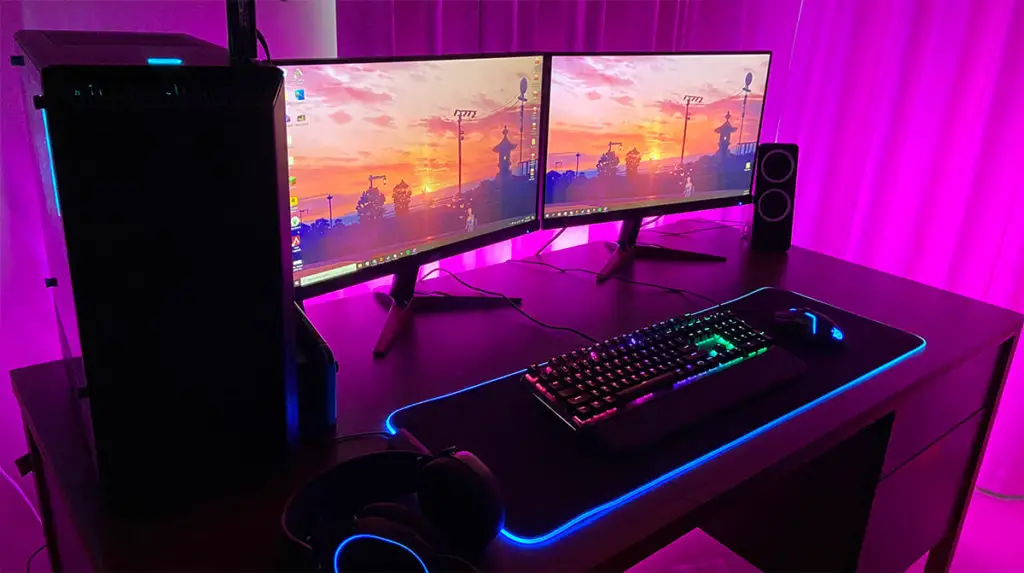You can also be interested in these:
- How to connect two TVs together using a single source
- What are the most used output ports in modern video cards?
- Gigabyte Aorus FO48U gaming monitor full review
- How to know what is my screen resolution easily
Computers these days are advanced to an astonishing degree. While 10 years ago you’d struggle to find monitors that could do full HD, now 4K UHD monitors aren’t just common, they’re quickly becoming the norm. With this knowledge, you may be asking yourself: Can my computer run 4K?

The answer to this question is a bit layered since there are a few ways to answer it. We’ll be taking a look at it from three different perspectives, and listing our research and findings in a neat pile so that you, the reader, can get a proper understanding of everything! So without further ado, let’s dive into the world of monitors, computers and crazy high display resolutions.
Can my computer run 4K content at all?
The first perspective we’ll be digging into is whether your computer can physically display 4K content at all. Before that though, we’ll need to make the distinction between full 4K and 4K UHD. It’s important in order to properly assess your options and not make a bad decision when buying your monitor.
So in a nutshell, full 4K resolution isn’t technically real 4K. In numbers, it’s written as 3840×2160, which is ridiculously high but not true 4K resolution. If you want real 4K, it’s called 4K UHD and in numbers it’s written as 4096×2304. On the market, fraudulent sellers will list full 4K and 4K UHD as the same thing to trick consumers, so always be wary of this.
Now, whether your computer can run 4K content in the first place is entirely dependent on your monitor and GPU. If your monitor can’t hit those crazy, crystal clear resolutions in the first place, then the obvious answer will be no. For GPUs, you’ll need to do some cross referencing with a list of 4K capable GPUs. Not to worry however, there’s an easier way to check.
On Windows, head over to your display settings menu and check your recommended display resolution. Whatever number is there dictates what resolution your PC can run, and if it’s lower than 4K then that means either your monitor or your GPU are a little lacking.
Finally, there’s the issue of ports, specifically HDMI and DisplayPorts. You’ll want to make sure your PC has either an HDMI 2.0 port or DisplayPort 1.4 port that supports 4K. Earlier versions of these ports unfortunately don’t support 4K resolutions whatsoever. In short, make sure your hardware supports 4k or you will be disappointed when your monitor arrives.
My PC is rated to run 4K content, but can it handle it?

Just because your setup can output 4K content does not necessarily mean it’ll do it well. Things like your GPU, monitor features and CPU can bottleneck your performance and make running anything in 4K chug to unwatchable levels. This is especially prevalent in heavier programs like video games and 3D modeling software where higher performance is often needed for smoother workflow.
For your monitor, you’ll want to ensure that it can run Nvidia G-Sync or FreeSync. These are technologies from Nvidia and AMD that allow you to run high quality 4K content and games without significant screen tearing ruining the experience. On top of that, while your GPU may be powerful enough, you’ll also want to make sure your CPU isn’t bottlenecking your performance. If it does, then your 4K content isn’t going to be very smooth, and you’ll be in for a rough time.
You’ll also need to consider your cooling solution here. While having your PC running 4K content will look fantastic, it creates greater strain on your internal components and brings up your temperatures by a significant amount. You do NOT want your expensive PC overheating and roasting your components, so keep and eye out for temps and consider investing in a quality cooling solution.
My specs are good, do I really need 4K?
This is an interesting perspective, and it’s a question of whether excess is always better. For starters, if you’re a gamer, you could be putting yourself at a sizable disadvantage when using a 4K monitor. Most 4K monitors aren’t built for gaming, and as such they’re often sold with lower refresh rates of 60Hz. Your graphics may be crispy, but you’re also missing out on precious frames per second here.
You’ll also need to consider how big your workspace is before getting a 4K monitor. On any monitor smaller than 27-inches, 4K is more of a gimmick, barely making a noticeable difference in visuals. It’s only once you go higher than 30-inches does 4K start to play a factor in graphical fidelity, and these displays are huge. If your work space doesn’t have much space, getting a 4K monitor might be more detrimental than helpful.
Another thing to consider is your internet bandwidth at home. Sure, getting access to beautiful 4K video streaming sounds like a luxury, but if your internet speeds aren’t fast enough, you’re not going to be able to enjoy it without heavy stuttering and pauses. At worst, you might even need to bump down the video resolution, taking away the main draw of having a 4K monitor in the first place.
Of course, these aren’t meant to discourage you from buying a 4K monitor. They’re a fantastic investment, and nothing beats watching extremely high definition content from the comfort of your own home. They’re just things to take into account so you won’t be stuck with an expensive monitor that actively hampers your experience.
Conclusion
4K monitors are a brilliant, but they’re also a premium item that have a lot of conditions to run properly. Can my computer run 4K? Is tough to answer because you need to split your answers into many different categories, which is what we’ve done here for you today.
We hope you found this helpful, especially if you’re currently in the market looking for a 4K monitor for your powerful setup. Use it as a guideline, and we can guarantee you won’t be going home disappointed!
More stories like this
- How to connect two TVs together using a single source
- What are the most used output ports in modern video cards?
- Gigabyte Aorus FO48U gaming monitor full review
- How to know what is my screen resolution easily
- Do you need a PC for a monitor to work properly?
- AMD Low Framerate Compensation (AMD LFC) explained
